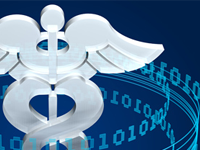
Doctors Look to Medical Informatics for Novel Cures
Medical researchers are becoming increasingly adept at wading into the massive data set that is the human genome and making tactical repairs to individuals’ DNA to cure genetic diseases. While the actual cutting and pasting that goes into so-called gene editing techniques is surprisingly simple, getting a handle on the intricacies of the data and potential ramifications of genetic treatment is extremely complex and fraught with challenges.
 Just as Amazon, Facebook, and Google use big data tools to predict customer preferences, the advent of medical informatics promises to reveal new ways to sift through mounds of medical data in search of better ways to diagnose, understand, and cure diseases.
Just as Amazon, Facebook, and Google use big data tools to predict customer preferences, the advent of medical informatics promises to reveal new ways to sift through mounds of medical data in search of better ways to diagnose, understand, and cure diseases.
As the potential for using data mining and analytic techniques to generate cures has become clearer, the medical informatics business has grown quickly, driven in part by government funding by programs such as the National Institutes of Health (NIH)’s Big Data to Knowledge (BD2K) program.
The Biomedical Informatics and Computational Biology (BICB) program at the University of Minnesota is one such program receiving federal funding. The graduate program started five years ago, and today has more than 50 students enrolled, according to a story in the Star Tribune of Minneapolis.
Biologists need a strong grasp on the quantitative tools, and the BICB hopes to give it to them, says Claudia Neuhauser, the mathematician who directs the program. “The onus is on [us] to develop ways of teaching so that biologists can fruitfully use the tools,” she says in the Star Tribune story.
Elsewhere on the University of Minnesota campus, medical doctors and PhD.s have joined forces to bring the new-found informatics techniques closer to clinical practice. The potential for novel cures is on display at the university’s Amplatz Children’s Hospital, where a seven-year-old Wisconsin boy recently underwent successful gene editing treatment for epidermolysis bullosa, a genetic disease that causes severe blistering.
The treatment, which was developed at the university’s Stem Cell Institute, involved mining a massive genomic database that was created by researchers in Germany, and using it to help them interpret the boy’s DNA. As a result, the doctors were able to snip out the defective segment of DNA, and replace it with the correct sequence. The boy’s body is now creating the “Type VII collagen” fibers that allow skin to stick to the body, according to the Star Tribune story.
Such treatments are still controversial in some parts of society, however, and there is a potential for gene treatment to do more harm than good. That puts pressure on everybody involved in developing gene editing treatments–including medical doctors, mathematicians, physicists, statisticians, computer engineers, and social scientists–to use the best data and wield the best tools in pursuit of new cures.
“We go from data to information, to knowledge to wisdom,” Dr. Jakub Tolar, director of the university’s Stem Cell Institute, tells the Star Tribune. “And unless we have a very systematic way of looking at the data, we will not only lose a lot of the information, but also, we will do harm, in my opinion.”
Related Items:
The Power and Promise of Data Driven Medicine
NIH Commits Nearly $100 Million to Build Big Data R&D Centers
Big Data Emerges in Indian Health Care






























